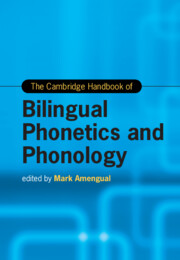Book contents
- The Cambridge Handbook of Bilingual Phonetics and Phonology
- Cambridge Handbooks in Language and Linguistics
- The Cambridge Handbook of Bilingual Phonetics and Phonology
- Copyright page
- Dedication
- Contents
- Figures
- Tables
- Contributors
- Acknowledgments
- Introduction Bilingual Phonetics and Phonology
- Part I Approaches to Bilingual Phonetics and Phonology
- 1 Generative Approaches to Bilingual Phonetics and Phonology
- 2 Usage-Based Approaches to Bilingual Phonetics and Phonology
- 3 Sociolinguistic Approaches to Bilingual Phonetics and Phonology
- 4 Psycholinguistic Approaches to Bilingual Phonetics and Phonology
- 5 Neurolinguistic Approaches to Bilingual Phonetics and Phonology
- 6 Computational Approaches to Bilingual Phonetics and Phonology
- Part II Theoretical Models of Bilingual Phonetics and Phonology
- Part III The Phonetics and Phonology of the Bilingual Child
- Part IV The Phonetics and Phonology of the Bilingual Adult
- Part V The Diversity of Bilingual Speakers
- Part VI Variables and Outcomes of Bilingual Speech
- Index
- References
1 - Generative Approaches to Bilingual Phonetics and Phonology
from Part I - Approaches to Bilingual Phonetics and Phonology
Published online by Cambridge University Press: 14 November 2024
- The Cambridge Handbook of Bilingual Phonetics and Phonology
- Cambridge Handbooks in Language and Linguistics
- The Cambridge Handbook of Bilingual Phonetics and Phonology
- Copyright page
- Dedication
- Contents
- Figures
- Tables
- Contributors
- Acknowledgments
- Introduction Bilingual Phonetics and Phonology
- Part I Approaches to Bilingual Phonetics and Phonology
- 1 Generative Approaches to Bilingual Phonetics and Phonology
- 2 Usage-Based Approaches to Bilingual Phonetics and Phonology
- 3 Sociolinguistic Approaches to Bilingual Phonetics and Phonology
- 4 Psycholinguistic Approaches to Bilingual Phonetics and Phonology
- 5 Neurolinguistic Approaches to Bilingual Phonetics and Phonology
- 6 Computational Approaches to Bilingual Phonetics and Phonology
- Part II Theoretical Models of Bilingual Phonetics and Phonology
- Part III The Phonetics and Phonology of the Bilingual Child
- Part IV The Phonetics and Phonology of the Bilingual Adult
- Part V The Diversity of Bilingual Speakers
- Part VI Variables and Outcomes of Bilingual Speech
- Index
- References
Summary
Generative phonologists share the goal of modeling the internalized grammars that allow members of a linguistic community to produce and understand utterances they have not previously encountered. But while most generativists assume that the internalized grammar maps lexical to surface representations, they may disagree on the nature of that mapping, the makeup of the mental representations of phonological structure, and the role of universal well-formedness constraints in grammar. This chapter surveys analyses of data from multilinguals, foreign language learners, and loanword adapters within different generative models, exploring both strengths and limitations of competing approaches. Issues addressed include the role of phonological vs. phonetic structure, the relationship between the production grammar and the perception grammar, and the role of putative innate learning biases vs. factors such as input frequency and perceptual salience.
Keywords
- Type
- Chapter
- Information
- Publisher: Cambridge University PressPrint publication year: 2024

